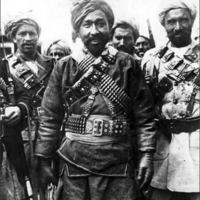Browse Exhibits (6 total)
Prevention and Management of Ethnic Conflict (Teaching Module)

This teaching module examines the National Delimitation Project in Soviet Central Asia in the 1920s and 1930s as a means to overcome ethnic strife. Using the primary source materials from the RPI collection, students will learn:
- How providing more opportunities for self-governing among ethnic groups was used in preventing and managing conflict
- What was the role of economic factors in reducing ethnic tensions
- How development of smaller administrative units based on ethnicity contribute to conflict management
Included is a description of theoretical concepts, case analysis, and bibliograhy.
Dynamics of Ethnic Conflict (Teaching Module)

This teaching module examines the dynamics of identity-based conflict as presented in the following 4-C model (Comparison, Competition, Confrontation, and Counteraction) in Soviet Central Asia. Using the primary source materials from the RPI collection, students will learn:
- How specific policies contributed to the experience of relative deprivation among ethnic groups in Central Asia
- How competition for the control of resources or power contributes to ethnic tensions
- The role of the third party (Russian army, Soviet government) in the exacerbation of ethnic tensions in Central Asia?
Included is a description of theoretical concepts, case analysis, and bibliograhy.
Containment of Islamic Insurgency (Teaching module)

This teaching module examines the case of the Basmachi movement as Islamic insurgency and identity-based conflict, and its containment by the government in Central Asia in the 1920s. Using the primary source materials from the RPI collection, students will learn:
- What political, economic, and social factors influenced people to join the Basmachi movement;
- What economic and social policies were effective in the containment of the mass violence;
- How the acceptance of both Soviet laws and the Sharia helped in fighting with the Islamist insurgency.
Included is a description of theoretical concepts, case analysis, and bibliograhy.
The Rise of Islamic Insurgency (Teaching module)

This teaching module examines the case of the Basmachi movement as Islamic insurgency in Central Asia in the 1920s. Using the primary source materials from the RPI collection, students will learn:
- What internal and external factors helped insurgency leaders to recruit local population;
- How the insurgency became a political movement;
- How inadequate government policies contribute to the rise of insurgency.
Included is a description of theoretical concepts, case analysis, and bibliograhy.
Nation Building as Identity-Based Conflict (Teaching Module)

This teaching module examines aspects of the National Delimitation Project in Soviet Central Asia in the 1920s and 1930s. Using the primary source materials from the RPI collection, students will learn:
-
How dynamics of identity-based conflict affect nation building process;
-
How memories and practices of colonial power impact relationships between groups during post-colonial period;
-
What factors lead to the rise of local nationalism during nation building project.
Included is a description of theoretical concepts, case analysis, and bibliograhy.
Formation of a Social Boundary (Teaching module)

This teaching module examines the case of the National Delimitation Project in Soviet Central Asia in the 1920s and 1930s. Using the primary source materials from the RPI collection, students will learn:
- How relative deprivation contributes to the formation of social boundary
- How collective axiology helps establish a firm social boundary and facilitates the rise of categorical violence
- The connections between social boundary, power, and legitimacy.
Included is a description of theoretical concepts, case analysis, and bibliograhy.
Featured Exhibit
Dynamics of Ethnic Conflict (Teaching Module)

This teaching module examines the dynamics of identity-based conflict as presented in the following 4-C model (Comparison, Competition, Confrontation, and...